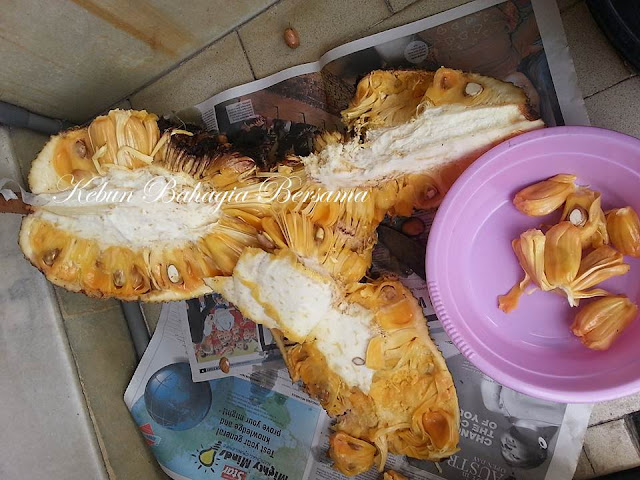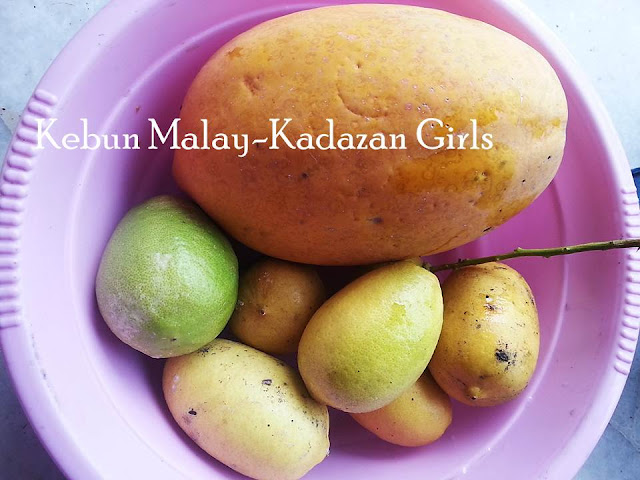One of the highlight on our recent trip to Sabah is visiting a protection site for Mahseer (kelah in Bahasa Malaysia) fish sanctuary. Earlier this year I did watch a documentary regarding this Mahseer fish sanctuary that can be visited and be very friendly with the Mahseer fish on one part region of Malaysia Sabah state. Never did I realised that in my mother own village so close to home we have also Mahseer sanctuary until I went to buy breakfast at Kiulu Tamu and one of my cousins that I met there told me about this special place. Never in my wildest dream I don't have to chase or coax the wild fish to come to us but they came swimming quickly toward us. Only rich people with money can eat Mahseer, I cannot afford to buy this fish. Even at rural market sells at RM20 per-kilogram. Well probably be at least double or triple price for the fish in town. I only get to eat it when my cousins caught some. So delicious simply melt in the mouth.

In Dusun-Kadazan the 'Tagal' is actually a traditional custom from long time ago where you cannot go fishing a certain area or there is only a certain season you can go fishing. The main reason is that there will be no intensive fishing and giving the chance the fish to mature and give offspring. For example on the board, the red zone is forbidden to fish because there is where the river flows very strong and fast. It is a perfect hotspot for Mahseer fish to lay eggs on the stone. The river next to our house is on the red zone where the kids usually have fun playing with water. My late-grandfather land is actually in between the red zone and yellow zone river.

Instead of using the main and only road for vehicles we decided to just walk to the fish sanctuary for the kids to have some adventure and toughen them up a bit. This will also be used as a landmark for the kids to remember the way when they are bigger and like to go on their own. They have to cross this watery spot by walking on the bamboo makeshift bridge.
Then up you climb the hill be careful if its wet due to the wet season. I don't usually like to use this path when its wet, so slippery when I was a kid. My slippers always got stuck on the muddy soil. There is another way boys but will show you next time walking through the rubber tree farms.When you reached up there, turn left walk until you see a small community hall (church?on the left side) and go down the hill. From up there you can see a kindergarten. But walk not towards the kindergarten but on the left follow the cement pathways straight ahead you will see a hanging bridge.
If you are unsure there will be a signboard 'Tagal'. Our host was Mr. Juara, very friendly and has been taking care of this visitor spots for a long time. When we came close to the river, the fish wasn't there yet but suddenly swiftly something coming towards us. You can see Abby looking down with an expression what is going on???

To our surprise and excitement, so many juvenile Mahseer surrounded us asking for food. So tame and trusting. They even suck our feet fingers which feels very ticklish, not painful. It has been raining in the afternoon everyday sometime till night so the water is consider big, usually its shallower and we can go further in the water. Since I can't see the bottom I am a bit hesitant to let the kids to go more deeper. I have been reminded so many time since I am small if I see black cloud further upstream of the river even it is not raining at my side not to play near the river. Because the river can rise and flow so fast which is very dangerous if you are swept away. But if its dry season , don't forget to bring some towels and change clothes and have fun playing in the water. On a sunny day and the rivers are its normal depth, I used to let myself be carried away by the swift river flow. My legs sometime have blue black bruises because I bang my legs on the stones while being taking along by the river flow to a calmer spot. Ouch, but fun. I did several times, just tiring to walk back to the starting point and especially you are going the opposite direction of the swift river flow.

Or you can also pick a spot and sunbath. I used to make my own pool when I was a kid. Make a pool by using the stones as wall. Sometime I would find a red stone, smash them and paint our face. I spend hours playing at the river during end year school holidays. You can also search for prawns underneath the stone close to the riverbed.

The caretaker would like to get more funds from government to add some more facilities in this fish sanctuary visitor centre. So far, toilet has been built from funds received from the government. The more visitors they received in their log record, it will be easier for them to apply for some funding to make it more comfortable for visitors. This rest house is kept very clean, there are tables and chairs you can have picnic. This place has a wide open space, if you want to organise a Family day for your company this will be a good place. You can also BBQ at this place and the whole family will enjoy this experience while having fun playing with fish and water. It is not faraway from the city Kota Kinabalu which is just less than one hour away. The government relies on the village co-operation for the tourism industry. To me as long as there is tourism and farming goods, hopefully there will be no plan for logging. I have seen areas which is close to logging areas and it was too painful to watch the river eco-system has been destroyed. Once was like the river in our village turn to muddy river, the heart feels very heavy. Sad the children could not play anymore near the river. My kids generation is still lucky and I hope it will always be a spot where children can enjoy the river. So future visitors, please come and visit this Fish Sanctuary you will be helping a lot to ensure this place will be safe.

It is very easy to go here, just follow the signboard to Kiulu White Water Rafting or Pukak Homestay until you reach Kampung Poturidong which is after the small Kiulu town. You will see a 'Tagal' signboard when you reach Kampung Poturidong and park your care next to the roadside and walk just a few metres away you will see a hanging bridge. This river is very popular for white water rafting (Gred 1) suitable for the whole family.

The village community representatives has tried to negotiate with tour operators to drop by before they drive further up to the white water rafting starting point. But the tour operators has not been giving much co-operation as their excuse is the time frame. Because after the rafting, they will rush to Klias river cruise for the probiscus monkey sightseeing which is actually not a reasonable excuse. Klias river cruise starts after 4-5PM in the afternoon the earliest because the probiscus monkey comes out at dusk to search for food. I still think they can make it if they leave at 2PM from the rafting end point. I think the tour operators should add the visit to the Mahseer Fish Santuary visitor centre at Poturidong to their itinerary. Well they will be passing the visitor centre anyway (see photo) so they actually can stop over for awhile. When I told my mama, regarding the discussion result with the tour operators, mama retorted the tour operators is considered very lucky already to use the river without any charge, they only has to invest on the equipment that will be used many time. The river they used is free yet they charge per-head close to RM200 now at least. Why not work together with the villager communities and avoid some friction near the future.




















































